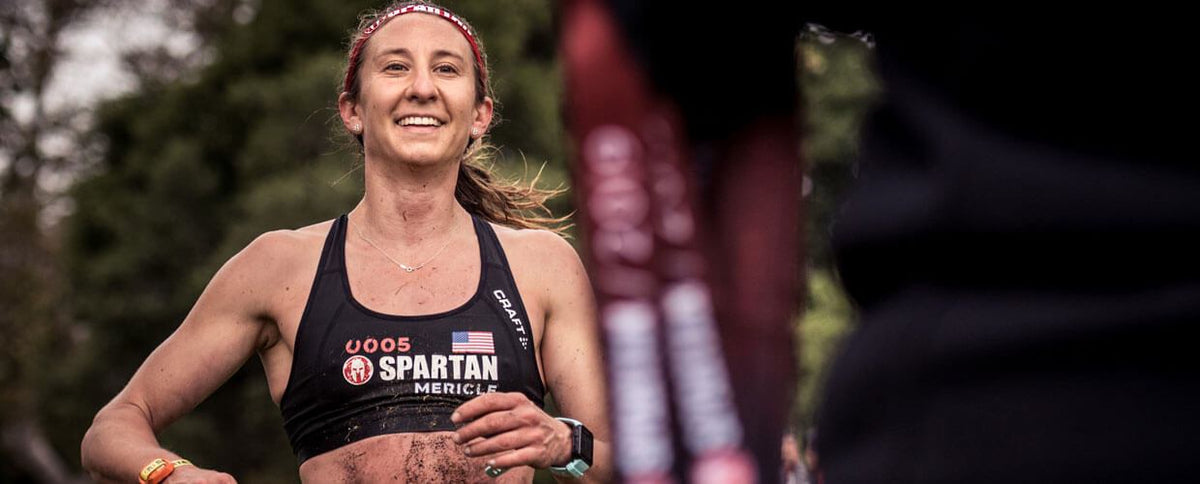How to Fuel Up (And Recover Smart): Q&A with Spartan Pro Nicole Mericle

Sponsored by our partner, Honey Stinger
Recovery is the single most underrated part of OCR training. When you recover well, you make big gains. When you don’t, you risk injury. It’s as simple as that. And 2019 World Champ Spartan Pro Nicole Mericle couldn’t agree more.
“You can work harder than anyone else, but if you don’t know how to recover, you won’t improve,” says Mericle. “Recovery isn’t just key to training, it is training. Nutrition, sleep, mobility, and mindset all contribute to recovery.” A well-rounded recovery plan boils down to replenishing your body’s fuel in all forms — from Zzz’s to H2O, but it starts with getting the right nutrients into your body so it can heal and push on. “An under-fueled athlete will end up injured or overtrained, eventually,” Mericle warns.
During exercise, your muscle fibers are broken down, and the repair of this tissue “damage” (a.k.a. recovery) is ultimately what makes us stronger. This is where post-workout nutrition (paired with active rest, like foam rolling) is so crucial to proper recovery.
“The nutrients we consume before and after a training session become so important,” says Corinna Coffin, MS, RD and Spartan Elite athlete. Carbs and protein, she says, are an athlete’s best friend when it comes to performance and recovery. Our muscles only store a finite amount of carbohydrates, so it’s important to replenish what we use. “After a training session, it’s vital for our bodies to receive nutrients that can be quickly digested and absorbed, in order to restore nutrients lost during activity, decrease protein breakdown, and stimulate muscle growth.” In essence, what you eat after a workout really matters.
Mericle, who takes her recovery nutrition very seriously, says she runs and climbs most days, regularly swims and lifts, and crosstrains on the side. “It can be hard to time meals well, so having quality snacks on hand is key for me to staying properly fueled throughout the day,” she says. Her favorite on-the-go snacks? The Honey Stinger Gluten Free Cinnamon Waffle (for longer-lasting energy) and Pomegranate Passion Fruit Energy Chews (for a quick boost). “I appreciate how they’re naturally flavored and organic, and I also like how they’re easy on my stomach,” she says. “If I’m feeling a little hungry and low on energy prior to a workout, I know I can eat these and carry on without problems.”
As she’s crushing Spartan titles and taking names, Mericle’s focus on recovery has become the backbone of her OCR success. And in addition to dialing-in the nutrition, we wanted to know what else makes for her perfect cocktail of recovery practices. So we asked her exactly what she does to rehab (and therefore perform!) so well. Here, get Mericle’s tried-and-true secrets to refuel, rest up, and dominate the course. Plus, her take on infrared saunas, and foam rolling tips to release your low back.
Q&A with Spartan Pro Nicole Mericle: How to Recover Smart
SPARTAN RACE: Why is recovery so important to you?
NICOLE MERICLE: When it comes to being the best in your sport or maximizing your personal performance, training and recovering thoughtfully trumps training harder and longer. I’m pretty confident that I don’t train the hardest out of my competitors. I run five days a week when others run seven. I do one hard running workout a week when others do two to three. What I do is listen to my coach and trust in the process that we’ve found to work for me. I sleep nine hours every night. I train intentionally and work hard when I need to. I also take life stress into account. If a big life event happens like a break up, a lost job, or a global pandemic, it’s important to take into account how this stress adds up. When in doubt, back off training intensity or volume to stay healthy. I’m not a robot and neither are you.
SR: How do you balance your recovery-to-workout ratio?
NM: After hard workouts, my priorities are refueling, rehydrating, and bodywork. It’s important to load hard days up and keep easy days free of extra work, like heavy lifting. On a hard workout day, I’ll typically have a 10-12 mile run with hill intervals, eat a snack or meal, and then get in a lifting session. I typically avoid rock climbing on hard workout days (or at least make sure I go very easy) because of the greater likelihood of injury under a fatigued and dehydrated state.
SR: What little things make a big difference in recovery?
NM: I find pool walking and mobility work to be incredibly beneficial after hard workouts. The water pressure is similar to wearing compression clothing. For this practice, I’d recommend light pool running or walking forward, backward, side to side, and even incorporate running drills while in the water for 10-15 minutes.
I also usually get a massage every other week and like to schedule those for the day after a hard workout. If you have a massage the day of a hard workout, I’d recommend spacing the massage out as much as possible from the hard session. Ideally, I do some light foam rolling and mobility, or easy yoga the day of a hard workout.
SR: What are your favorite foam rolling techniques to release tension?
NM: I use the foam roller primarily to roll my back. Right before I run, I roll over my legs a few times to prime my muscles. The Roll Recovery is great because it allows you to roll groups of muscles at once: quads and hamstrings, IT band and adductors, glutes and hip flexors, and calf and shins. I use the Theracane to perform a self-active release on my back. With all the climbing I do, I have a tendency to strain muscles that pull on my ribs. With the Theracane, I can put pressure on an area while moving my arm across my body or upward, like my physical therapist would do.
SR: Infrared saunas are all the rage lately, being touted as insanely good for recovery — are you into them?
NM: I like getting in the sauna for the cardiovascular and heat training benefits. I consider the sauna more of a training tool and less a recovery practice, although it can also be relaxing and beneficial for circulation after workouts. I especially like using the sauna in the winter, and usually taper off this practice in the summer when I sweat more and have a harder time rehydrating and replenishing electrolytes and minerals. Keep in mind that you lose more than just water when you sweat. Rehydrate with an electrolyte drink and weigh the cost to benefit from sweating more. For instance, I’m prone to muscle twitches and low iron levels, so I’m mindful of all the ways I could be losing iron and electrolytes — including from sweat.
SR: What do you eat right after a strenuous workout?
NM: Simple carbohydrates are great after workouts to restore your glycogen levels. My favorite treat is a Honey Stinger cinnamon waffle, but it’s also a good time to indulge in a little candy guilt free. I aim to have a 200-600 calorie snack/meal that has a carbohydrate to protein ratio of about 4:1 or 3:1. A Honey Stinger cracker or protein bar is a great option, too. Just make sure to add a banana or nut butter if you need more carbohydrates or protein.
SR: What’s your general approach to nutrition and how does it factor into your recovery regimen?
NM: It’s important to replenish glycogen stores, lost electrolytes, and provide your body with enough calories to rebuild muscle tissue broken down from workouts. My approach to nutrition is to focus on whole foods, always eat until I’m full, and resist food restrictions. Most of the time I’ll pick things like sweet potatoes, rice, chicken, brussel sprouts, and berries to eat, but if I want jalapeno kettle chips or sour patch kids one day, I’ll eat those too. Restricting foods can be a slippery slope. Ask yourself what sounds yummy AND nutritious? or what is going to refuel my body well?, instead of putting foods into “bad” or “off limits” categories and asking “what should I not eat?” As an athlete, it’s not always about having a 100% perfect diet, but rather having a healthy and sustainable mindset.
Like any other aspect of training, nutrition takes some thought and planning. Prepping meals beforehand is a great way to ensure you’ll have nutritious food when you need it. The same goes for when you need a treat! I like to keep dark chocolate, berries, and gummy worms (that have real sugar and fruit juice, instead of corn syrup and artificial flavorings) on hand for when I need a sweet treat...which is every day, for me. I try to pick sweets that have some benefit, like antioxidants, and simple ingredients.











